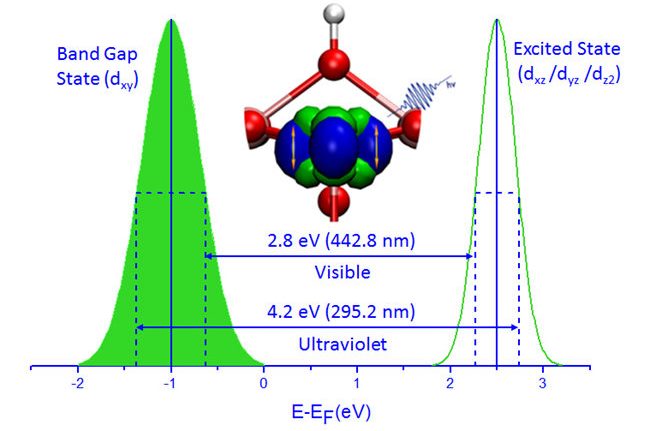
As a prototypical metal oxide in solar energy conversion, TiO2 is easily reduced, forming Ti3+ ions, for which a characteristic signature is the presence of a localized state in the band gap at ~ 1 eV below the Fermi level (EF). There is evidence that d→d transitions from the gap states contribute to the photoabsorption of reduced TiO2. In addition, due to the band gap narrowing and enhanced photo-absorption associated with the presence of band gap state, visible light photocatalysis through Ti3+ self-doping has also been achieved.
While transitions from the band gap state are clearly important, little is known, however, about the character of the electronic excited states that are involved in these transitions, also due to the greater difficulty to experimentally access unoccupied states in comparison to occupied ones. A characterization of these states is not only scientifically interesting, but is also important for a better understanding and control of TiO2 photocatalysis.
Led by Prof. YANG Xueming, researchers from the Dalian Institute of Chemical Physics have recently revealed the physical origin of Ti3+ ions related electronic structure in TiO2, in collaboration with Prof. LIU Limin from Beijing Computational Science Research Center and Prof. Annabella Selloni from Princeton University. The results entitled “Localized Excitation of Ti3+ Ions in the Photoabsorption and Photocatalytic Activity of Reduced Rutile TiO2” have recently been published online in Journal of the American Chemical Society.
Followed by their previous studies (Chemical Science, 2010, 1, 575; Chemical Science, 2011, 2, 1980; Energy and Environmental Science, 2012, 5, 6833; J. Phys. Chem. Lett., 2013, 4, 3839), researchers utilize a combined two-photon photoemission spectroscopy (2PPE) and density functional theory (DFT) calculations to investigate the electronic structure of reduced TiO2.
They disclose the John-Teller splitting of the 3d orbitals of Ti3+ ions of TiO2(110) into band gap states (~ 1 eV below EF) and excited states (~ 2.5 eV above EF) which are of dxy, dxz/dyz/dz2 character, respectively. Localized excitation of Ti3+ ions through d→d transition from the widely distributed band gap states and excited states extends the photo-absorption into the visible region. They have identified the Ti3+ related intrinsic excited state which was thought to be an adsorbate induced feature previously (Science, 2005, 308, 1154; Science, 2006, 311, 1436), provided a thorough analysis of the photoabsorption of TiO2, explained the visible light photocatalysis associated with Ti3+ self-doping and also paved the way for the investigation of the electronic structure and photoabsorption of other metal oxides.
This work was financially supported by the National Natural Science Foundation of China (NSFC), the National Basic Research Program of China and the Key Research Program of the Chinese Academy of Science.

Extended Photoabsorption via the localized excitation of Ti3+ in TiO2 (Image by DICP)

86-10-68597521 (day)
86-10-68597289 (night)

86-10-68511095 (day)
86-10-68512458 (night)

cas_en@cas.cn

52 Sanlihe Rd., Xicheng District,
Beijing, China (100864)

